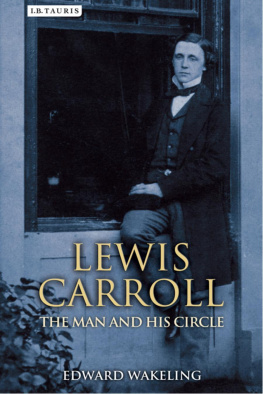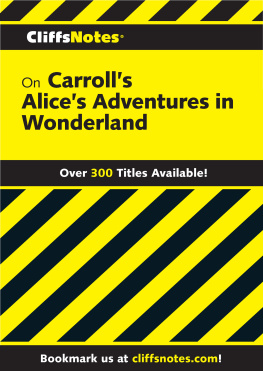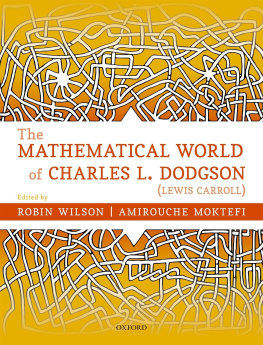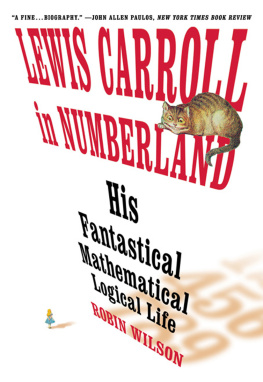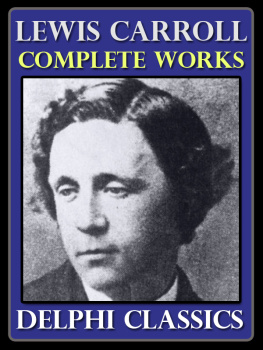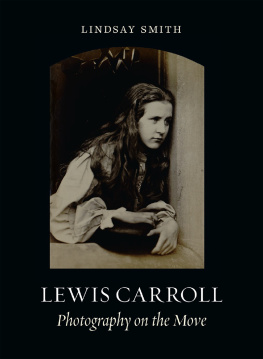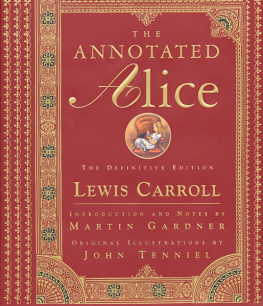Edward Wakeling is an international authority on Lewis Carroll and owns one of the finest collections of Carroll material in private hands. A former chairman of the Lewis Carroll Society, he edited the ten volumes of Lewis Carrolls Diaries and regularly acts as a consultant to auctioneers, television programmes and exhibitions worldwide. His books include Lewis Carrolls Oxford Pamphlets (University of Virginia Press, 1993), Lewis Carroll Photographer (with Roger Taylor, Princeton University Press, 2002) and Lewis Carroll and his Illustrators (with Morton N. Cohen, Cornell University Press, 2003).
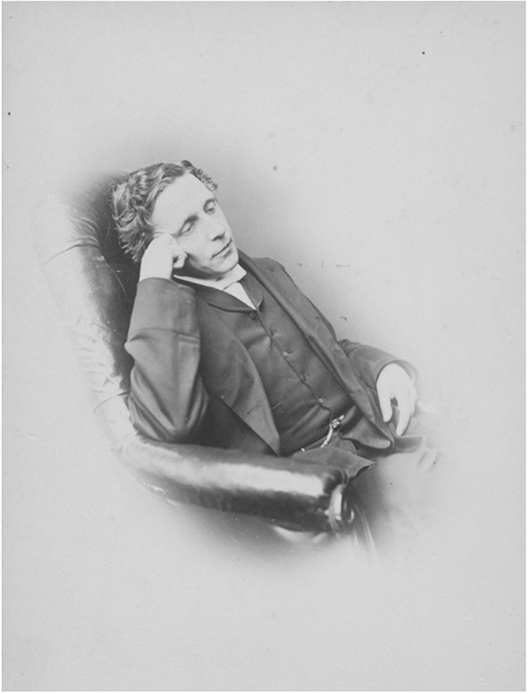
Frontispiece: Charles Lutwidge Dodgson (Lewis Carroll) from an assisted self-portrait taken in 1875, from the authors collection
LEWIS CARROLL
THE MAN AND HIS CIRCLE
EDWARD WAKELING
Published in 2015 by I.B.Tauris & Co Ltd
6 Salem Road, London W2 4BU
175 Fifth Avenue, New York NY 10010
www.ibtauris.com
Distributed in the United States and Canada Exclusively by Palgrave Macmillan
175 Fifth Avenue, New York NY 10010
Copyright 2015 Edward Wakeling
Copyright Foreword 2015 Rhona Lewis
The right of Edward Wakeling to be identified as the author of this work has been asserted by him in accordance with the Copyright, Designs and Patents Act 1988.
All rights reserved. Except for brief quotations in a review, this book, or any part thereof, may not be reproduced, stored in or introduced into a retrieval system, or transmitted, in any form or by any means, electronic, mechanical, photocopying, recording or otherwise, without the prior written permission of the publisher.
ISBN 9781780768205
eISBN 9780857738516
A full CIP record for this book is available from the British Library
A full CIP record is available from the Library of Congress
Library of Congress Catalog Card Number: available
Contents
List of Illustrations
Family Trees
Foreword
Lewis Carroll is many things: a play on words, a nom de plume , a screen to protect a living person from intrusive curiosity. Charles Dodgson, whose pen name it was, has remained a source of continuing fascination. Who was the man who invented the stories of Alices Adventures in Wonderland and Through the Looking-Glass and who composed the sublime nonsense of The Hunting of the Snark ? What was he like? Some of his former mathematics students were themselves astonished to learn that Lewis Carroll was Charles Dodgson. One of them, Lord Redesdale, said that he could never have guessed that the uncharismatic teacher who delivered his lectures in a singularly dry and perfunctory manner was hatching in his fertile brain such a miracle of fancy and fun as Alice in Wonderland.
Charles Dodgson was himself many things. He was a storyteller, parodist, verse writer, mathematician, logician and artist-photographer. He was a devoted son, entertainer of his ten siblings, a brother who saw to it that his unmarried sisters should never live in want. For forty-seven years he was a member of Christ Church in Oxford, arriving as an undergraduate at the age of 18 and dying as a senior student and member of the governing body of Christ Church at the age of 65. He kept scrupulous records of his diverse activities, but they are not journals of psychological introspection. Succeeding generations, however, in their fascination with the person behind the name, have probed aspects of his life story and suggested different interpretations of his works. Some who have written about him have transferred anachronistic mindsets and worldviews onto Dodgson and his world.
In Edward Wakelings book we have a new enterprise. Wakeling, the editor of the ten volumes of Dodgsons diaries, introduces us to Lewis Carroll in the flesh and blood contexts of his circle or, perhaps to use a mathematical image the contexts of the circles within his circle. These were his family, academic associates, book producers, photographers, professional people and acquaintances. Wakeling has an exhaustive knowledge of the primary sources, including previously undiscovered and unpublished letters. He presents a wealth of little-known and meticulously researched background material to paint a picture of Dodgson and his circle which breathes with life. Everything Wakeling says is based on a careful assessment of the sources. At moments the text is racy; at other times, the text describes with clarity the topics of mathematics and logic that absorbed Dodgson. At yet other times, Wakeling quietly explodes some of the myths that have been circulated by speculative and ignorant authors. Above all, he introduces us to Lewis Carrolls family, friends, associates and acquaintances. We hear them speak, and through their voices in conversation with Lewis Carroll, we get to know Mr Dodgson and can be fascinated by the man as he was.
Rhona Lewis
The Deanery, Christ Church, Oxford
Preface
The last one hundred years have seen enough biographies of Lewis Carroll (Charles Lutwidge Dodgson) to make another seem superfluous. Yet there remains much to be learnt about this world-famous author by considering, in more detail, the people he mixed with and their relationship with him. In addition, we have a wealth of new primary sources to draw upon. Many previously unpublished letters have come to light, his catalogue of photographs taken over a period of twenty-five years has been reconstructed; his surviving diary is now published and annotated; and rare manuscripts from archives dotted around the globe have emerged. Much new research has taken place and there is a new, fuller and more accurate story to tell.
I have studied these sources carefully for almost forty years, editing the diaries for publication and compiling databases of Dodgsons surviving correspondence (much unpublished) and his photographic opus (through a reconstruction of his register of prints). I feel it is now time to present my view of Lewis Carroll. And I have chosen to do so through his relationship with his circle of family, friends and acquaintances. This will fill gaps in previous biographies, particularly regarding his mathematical role a central theme yet one often dealt with in a surprisingly cursory manner given it was his main career. Very few biographers have touched on his entrepreneurial spirit a man who always looked for new markets for his publications and who asked brokers to invest his book profits in the stocks and shares of steamships and railway companies. Nor have biographers dealt with Dodgson as a loyal subject of royalty a man who knew personally members of the royal family and who befriended princes and princesses.
Over many years I have written papers on a wide variety of topics covering the life and works of Lewis Carroll and I have drawn from these to assemble this current study of his own circle within Victorian society. I have kept to the facts, commenting on his personality from a basis that decades of study and research are likely to have given me a better picture than one based on reading a couple of previous biographies. Having spent more than fifteen years editing his diaries, I have a sense of what this man would do and what he would not do, of what he believed in and what he did not. Most people are shaped and influenced by their family, friends and acquaintances, so I have incorporated character studies of some key people in his life people whom he admired and treasured as close friends and valued advisers.

